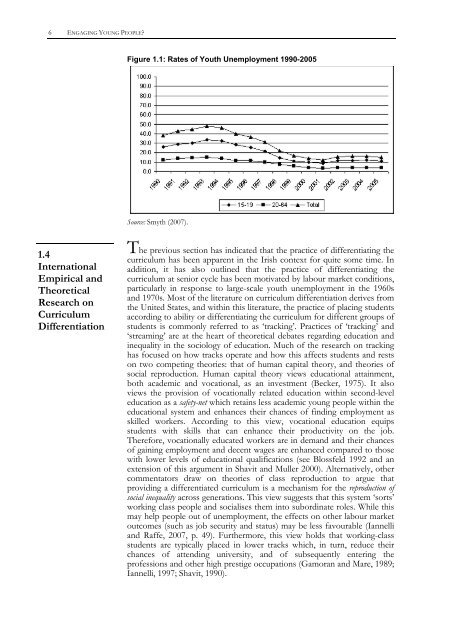6 ENGAGING YOUNG PEOPLE?Figure 1.1: Rates <strong>of</strong> Youth Unemployment 1990-2005Source: Smyth (2007).1.4InternationalEmpirical andTheoreticalResearch onCurriculumDifferentiationThe previous section has indicated that <strong>the</strong> practice <strong>of</strong> differentiating <strong>the</strong>curriculum has been apparent in <strong>the</strong> Irish context for quite some time. Inaddition, it has also outlined that <strong>the</strong> practice <strong>of</strong> differentiating <strong>the</strong>curriculum at senior cycle has been motivated by labour market conditions,particularly in response to large-scale youth unemployment in <strong>the</strong> 1960sand 1970s. Most <strong>of</strong> <strong>the</strong> literature on curriculum differentiation derives from<strong>the</strong> United States, and within this literature, <strong>the</strong> practice <strong>of</strong> placing studentsaccording to ability or differentiating <strong>the</strong> curriculum for different groups <strong>of</strong>students is commonly referred to as ‘tracking’. Practices <strong>of</strong> ‘tracking’ and‘streaming’ are at <strong>the</strong> heart <strong>of</strong> <strong>the</strong>oretical debates regarding education andinequality in <strong>the</strong> sociology <strong>of</strong> education. Much <strong>of</strong> <strong>the</strong> research on trackinghas focused on how tracks operate and how this affects students and restson two competing <strong>the</strong>ories: that <strong>of</strong> human capital <strong>the</strong>ory, and <strong>the</strong>ories <strong>of</strong>social reproduction. Human capital <strong>the</strong>ory views educational attainment,both academic and vocational, as an investment (Becker, 1975). It alsoviews <strong>the</strong> provision <strong>of</strong> vocationally related education within second-leveleducation as a safety-net which retains less academic young people within <strong>the</strong>educational system and enhances <strong>the</strong>ir chances <strong>of</strong> finding employment asskilled workers. According to this view, vocational education equipsstudents with skills that can enhance <strong>the</strong>ir productivity on <strong>the</strong> job.Therefore, vocationally educated workers are in demand and <strong>the</strong>ir chances<strong>of</strong> gaining employment and decent wages are enhanced compared to thosewith lower levels <strong>of</strong> educational qualifications (see Blossfeld 1992 and anextension <strong>of</strong> this argument in Shavit and Muller 2000). Alternatively, o<strong>the</strong>rcommentators draw on <strong>the</strong>ories <strong>of</strong> class reproduction to argue thatproviding a differentiated curriculum is a mechanism for <strong>the</strong> reproduction <strong>of</strong>social inequality across generations. This view suggests that this system ‘sorts’working class people and socialises <strong>the</strong>m into subordinate roles. While thismay help people out <strong>of</strong> unemployment, <strong>the</strong> effects on o<strong>the</strong>r labour marketoutcomes (such as job security and status) may be less favourable (Iannelliand Raffe, 2007, p. 49). Fur<strong>the</strong>rmore, this view holds that working-classstudents are typically placed in lower tracks which, in turn, reduce <strong>the</strong>irchances <strong>of</strong> attending university, and <strong>of</strong> subsequently entering <strong>the</strong>pr<strong>of</strong>essions and o<strong>the</strong>r high prestige occupations (Gamoran and Mare, 1989;Iannelli, 1997; Shavit, 1990).
THE POLICY BACKGROUND TO THE LEAVING CERTIFICATE APPLIED PROGRAMME 7From <strong>the</strong> school perspective, tracking is seen as a way to match teachingand learning to <strong>the</strong> abilities and orientations <strong>of</strong> different groups <strong>of</strong> studentsin order to foster educational development for all (Oakes, 2000, p. 2).However, it has been argued that <strong>the</strong> practice <strong>of</strong> tracking has not, in fact,resulted in parity <strong>of</strong> esteem across different groups (Oakes, 2000, p.2).While <strong>the</strong> previous section has shown that since <strong>the</strong> 1960s, Irish youthshave been channelled towards different types <strong>of</strong> programmes at seniorcycle, debates about how students are channelled towards <strong>the</strong>se differenttrajectories have largely been absent from Irish studies, with a focus insteadon <strong>the</strong> outcomes <strong>of</strong> programme participation.The international research suggests that students from different socioeconomic(class and income) backgrounds, ethnic backgrounds andstudents with different academic abilities enrol in different types <strong>of</strong>programmes at upper secondary level. That is, working-class students aretypically placed in lower tracks, a process which reduces <strong>the</strong>ir chances <strong>of</strong>attending third-level education or entering pr<strong>of</strong>essions and o<strong>the</strong>r highprestige occupations (Gamoran and Mare, 1989; Shavit, 1990; Iannelli,2000; Arum and Shavit, 1995). A number <strong>of</strong> international studies haveconsidered how students are assigned to tracks (see for example Oakes andGuiton, 1995; Lucas 1999; Ainsworth and Roscigno, 2005). These studiessuggest that, in practice, <strong>the</strong> assignment <strong>of</strong> students into tracks is not onlybased on academic considerations, such as grades, scores on standardisedtests, teacher and o<strong>the</strong>r school staff recommendations, prior trackplacement and course prerequisites. Non-academic considerations in thisbody <strong>of</strong> research have included course conflict (timetabling), co-curricularand extracurricular schedules, work demands, teacher and curricularresources and <strong>the</strong> transfer <strong>of</strong> social, economic and political resources.Fur<strong>the</strong>rmore, track assignment is dependent on <strong>the</strong> schools that studentsattend because schools vary in <strong>the</strong> range <strong>of</strong> factors on which <strong>the</strong>y rely toassign students to tracks, and <strong>the</strong> weight that <strong>the</strong>y attach to each factor.Sociologists differ in terms <strong>of</strong> how <strong>the</strong>y see processes <strong>of</strong> curriculumdifferentiation in <strong>the</strong> context <strong>of</strong> <strong>the</strong> overall educational system. While someprefer to focus on <strong>the</strong> ‘unintended consequences’ <strong>of</strong> curriculumdifferentiation (see for example, Shavit, 1990, Hallinan, 2007; Shavit andMuller, 2000), o<strong>the</strong>rs see curriculum differentiation as an intended method<strong>of</strong> reproducing social inequality (see for example Bowles and Gintis, 1976;Bourdieu and Passeron, 1990). The former social stratification <strong>the</strong>orists<strong>of</strong>fer explanations as to why different groups <strong>of</strong> people pursue differenttypes <strong>of</strong> programmes. First, attending a class alongside highly motivatedand academically successful students enhances one’s own chances <strong>of</strong>success (Coleman et al., 1966; Hallinan and Williams, 1990). Since ‘lower’tracks are usually attended by academically weaker students, <strong>the</strong>y aredeprived <strong>of</strong> <strong>the</strong> beneficial effect <strong>of</strong> a more favourable milieu. Second, lessacademic tracks such as <strong>the</strong> LCA <strong>of</strong>fer a more restricted curriculum and<strong>the</strong>ir students are less likely to take advanced courses (Gamoran, 1987;Oakes, 1985). Third, in such tracks, less time may be devoted to actualinstruction, and instruction is conducted at a lower level <strong>of</strong> intellectualcomplexity (Oakes, 1985). Consequently, students in <strong>the</strong> lower tracks learnless than those in <strong>the</strong> upper tracks and are less likely to succeed in collegeadmission tests. Fourth, being placed in a lower track or ability groupsignals to students that <strong>the</strong>y are less worthy, which in turn dampens both<strong>the</strong>ir expectations <strong>of</strong> what <strong>the</strong>y can achieve and <strong>the</strong>ir aspirations for <strong>the</strong>future (Vanfossen et al., 1987). Thus, placement in such a track at <strong>the</strong>

















